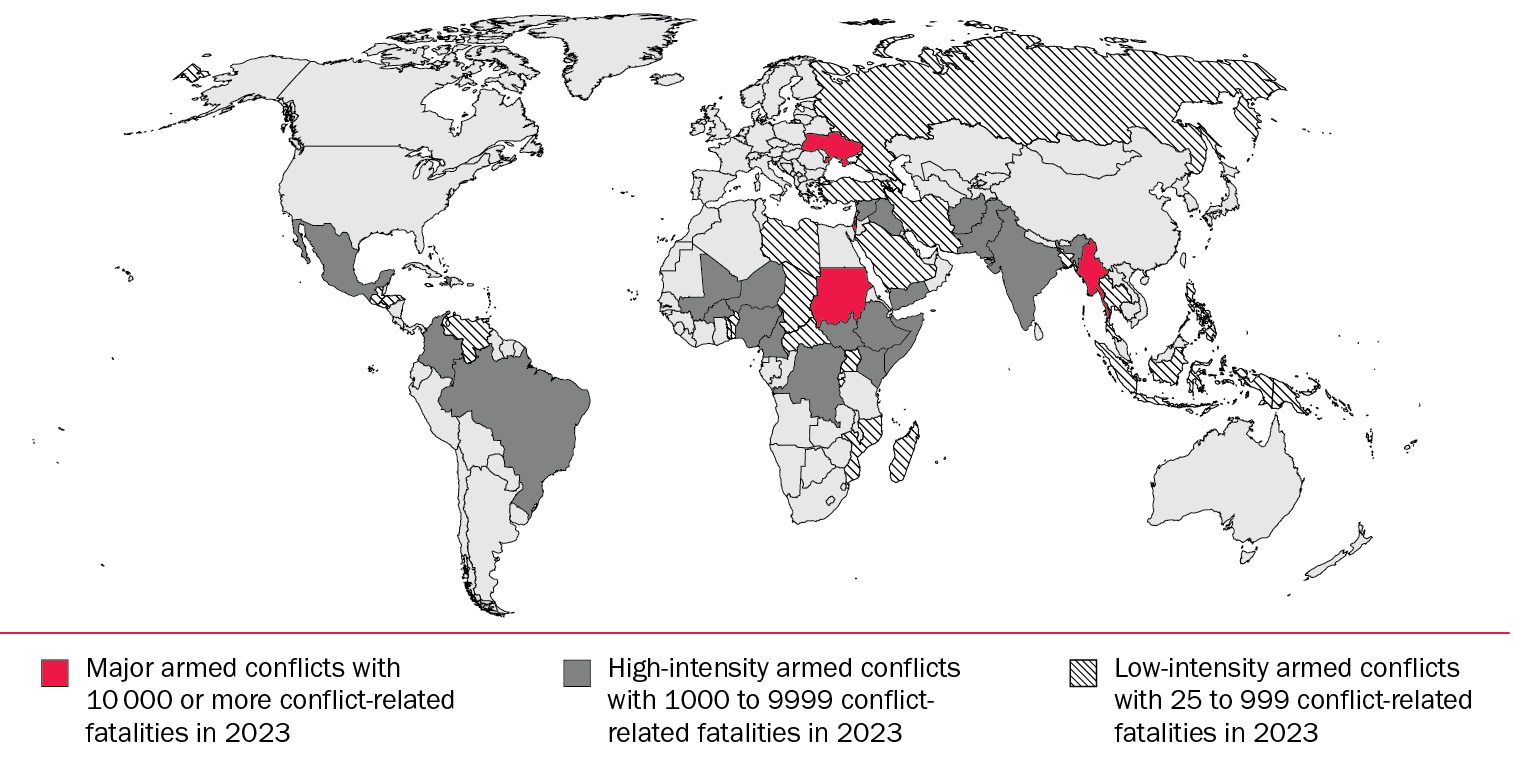2. Trends in armed conflicts
Overview, Richard Gowan
I. Global trends and regional developments in armed conflict, Richard Gowan
II. Peace processes, Richard Gowan
III. Armed conflicts active in 2023, Ian Davis
Although the number of states experiencing armed conflicts fell from 55 in 2022 to 52 in 2023, the estimated number of conflict-related fatalities worldwide rose from 153 100 in 2022 to 170 700 in 2023, to reach the highest level since 2019. In 2023 there were four conflicts categorized as major armed conflicts (i.e. conflicts involving 10 000 or more conflict-related fatalities in the year), which was one more than in 2022: the civil wars in Myanmar and Sudan; and the Israel–Hamas and Russia–Ukraine wars. The number of high-intensity armed conflicts (i.e. conflicts involving 1000–9999 conflict-related fatalities) also increased, from 17 in 2022 to 20 in 2023.
Armed conflicts by number of estimated conflict-related fatalities, 2023
Note: The boundaries used in this map do not imply any endorsement or acceptance by SIPRI.
Europe
The Russia–Ukraine war ground on throughout 2023, at a high cost to both sides, but the front line in eastern and southern Ukraine remained little changed by the end of the year. Russian air attacks continued and Ukraine began to reply in kind, although not on the same scale. Both sides sought and received ammunition and weapons from their allies. There were no formal Russian–Ukrainian peace talks during the year and the one noteworthy diplomatic success—the 2022 Black Sea Grain Initiative—unravelled in 2023. The International Criminal Court intervened in March by issuing arrest warrants for Russian President Vladimir Putin and another Russian official for their roles in the deportation of Ukrainian children.
In contrast to the stalemate in Ukraine, in September 2023 Azerbaijan secured a decisive victory in its long-running conflict with Armenia over Nagorno-Karabakh.
The Middle East and North Africa
There was significant instability in the Middle East and North Africa (MENA), even before Hamas’s attack on Israel on 7 October 2023. High-intensity armed conflicts continued in Iraq, Syria and Yemen throughout the year. The overall estimate of 35 900 conflict-related fatalities in MENA for 2023 was more than twice the estimate for 2022 (16 900), but was still less than half the estimate for 2018 (75 400).
Israel responded to the events of 7 October—the killing of over 1000 civilians and more than 350 Israeli soldiers
and police, and the capture of around 240 hostages—by declaring a state of war for the first time since 1973. By the end of the year more than 22 000 Palestinians had been killed in the ensuing air strikes or ground operations by Israel, and international experts warned of a growing risk of famine. In December South Africa asked the International Court of Justice to address the charge that Israel was committing genocide in Gaza.
The war increased already heightened tensions in MENA. For example, Houthi forces in Yemen, claiming support for the Palestinians, started to attack commercial shipping in the Red Sea, prompting Western powers to dispatch warships to the area to address the threat.
Sub-Saharan Africa
Sub-Saharan Africa remained the region with the most armed conflicts, although many were low-intensity conflicts involving fewer than 1000 conflict-related fatalities and levels of violence fluctuated considerably. There were decreases in conflict-related fatalities in several countries experiencing high-intensity armed conflict, including the Democratic Republic of the Congo, Ethiopia, Nigeria and South Sudan. However, there were notable increases in conflict-related fatality rates elsewhere, including in Sudan (+537 per cent compared with 2022), Burkina Faso (+100 per cent) and Somalia (+28 per cent). The fighting that erupted in Sudan on 15 April 2023 between forces led by rival military generals triggered a humanitarian crisis and resulted in all-out civil war. In the Sahel, a coup in Niger and a decision by Mali to expel United Nations peacekeepers added to regional tensions.
The Americas, and Asia and Oceania
The Americas is the only region not to have had a major armed conflict in the period 2018–23. The two countries in the region with the highest number of conflict-related fatalities—Brazil and Mexico—largely faced criminal rather than political violence in 2023. Criminal gang-related violence also escalated significantly in Haiti during the year.
Despite the ongoing civil war in Myanmar, the overall conflict-related fatality rate for Asia and Oceania more than halved between 2021 and 2023. This was partly due to a continuing decline in conflict-related fatalities in Afghanistan following the return to power of the Taliban in 2021.
Peace processes
Opportunities for peacemaking were limited in 2023. In Yemen, the UN began the year attempting to restart a truce between the Houthis and the Yemeni government and by the end of 2023 both sides were pledging to develop a road map for a new ceasefire. In Ethiopia, the government and the Tigray People’s Liberation Front worked on implementing their November 2022 ceasefire with the support of a small African Union monitoring mission. Meanwhile, in Colombia, the government made some progress on a peace initiative with several armed groups.
